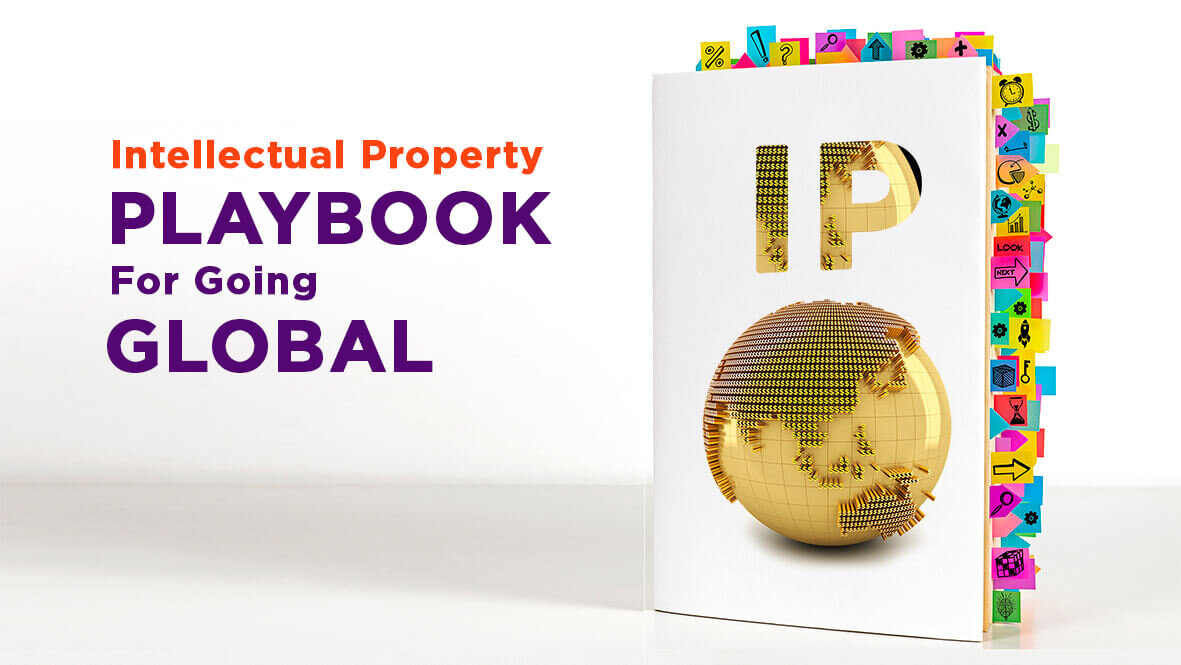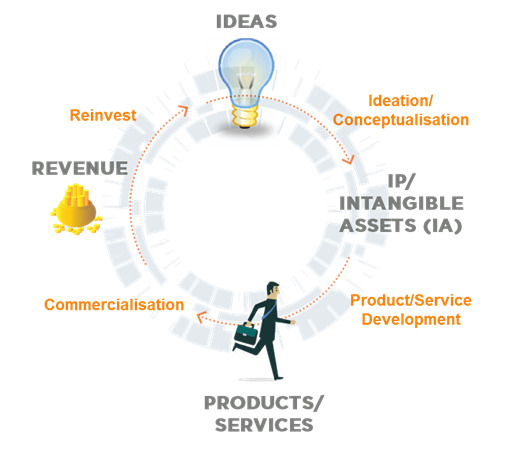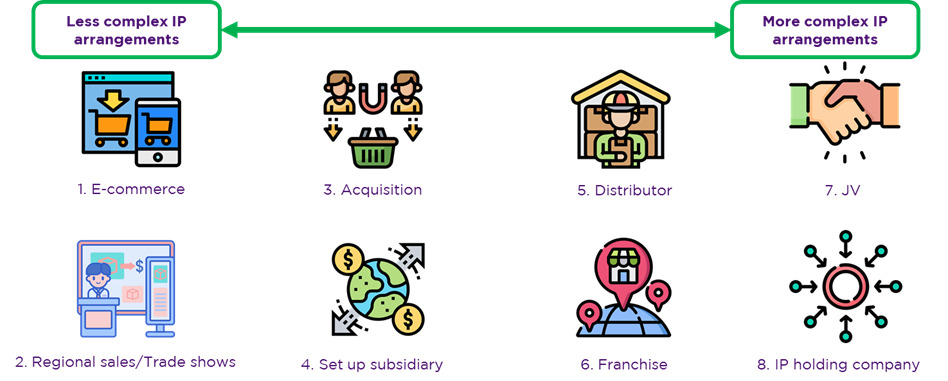
IP Playbook for Going Global

(This article was first published in the Oct-Dec 2020 edition of the Asia Franchise & Business Opportunities magazine.)
So, your company has reached a milestone. Sales are good and you are finding the local market a little saturated. You have a good product and you are eager to grow your business further.
Perhaps it’s time to start looking overseas?
The natural way to expand internationally in the past might be to set up an overseas office. In this present day and age however, this really is just one of many strategic choices available to you. Regardless of your choice, you need to know that action needs to be taken regarding your intangible assets.
Ask any company about their inventory of physical assets and there is a good chance that they will be able to come up with a list of plant, machinery, furniture, vehicles, IT hardware and so on. Ask the same company about their intangible assets and you may find that they struggle to produce a similar list. It is certainly not for a lack of these intangible assets. Rather, as the name suggests - intangible assets (IA) are non-physical and hence are not at the “top of mind” in the same way physical assets are.
Read also: Coffee Break - How many intangible assets are in a cup of coffee?
Intangible assets—drivers of value creation
While most businesses are aware of a subset of intangible assets called intellectual property (IP) – which include patents, trademarks, registered designs, copyright and trade secrets; many of these companies are unaware that customer lists, supplier lists, databases, manuals, catalogues, regulatory approvals, systems and processes, contracts and agreements count toward their intangible assets.
These intangible assets form the underlying core of how businesses are innovating. It is through innovation that these intangible assets are created. While businesses are focused on identifying their competitive edge, they tend to overlook the fact that what really defines the competitive edge are their scalable intangible assets. This is becoming increasingly evident when we look at how much intangible assets now form the key asset of businesses [1].
Where does IP fit in your innovation journey?
The OECD defines innovation as “the implementation of a new or significantly improved product (good or service), or process, a new marketing method, or a new organisational method in business practices, workplace organisation or external relations”.[2] Innovation is about bringing ideas to the market.
Innovation should not be a one-off event (see Diagram 1). To continually hold the competitive edge, businesses should look at innovation as a continuous cycle of ideas. You start with ideas and turn them into intangible assets. You then leverage these intangible assets to differentiate you from your competitors, commercialise them get in the revenue and reinvest in the next generation of innovation.

Imagine IP as the vehicle in the cycle where ideas are taken to the market. When strategically and effectively used, IP enhances an enterprise’s competitive edge, facilitates growth and success in reaching the marketplace. IP provides financial opportunities like sale, licensing and business partnerships.
When planning for overseas expansion, you need to incorporate your IP strategy into your business expansion plans. Similar to the identification of markets, you will identify your IP assets. When assessing the viability of these markets, you should also assess whether your IP assets can be used in these markets. Just like how you will adapt your products and services for a market, adapt your IP assets for local use.
What business expansion strategy suits you best?
In considering what sort of overseas business expansion strategy suits you best, you need to think about the potential drawbacks and costs, and how well aligned each option is with your resources and goals. Diagram 2 lists some common market entry approaches and may help you appreciate how ‘IP intensive’ your proposed international expansion strategy might be.

In approaches 1 and 2, from the establishing of a website or placing your goods and services on an e-commerce platform to selling directly to your overseas client through periodic visits and trade shows are likely to be the least complex in IP terms. Assuming that you have the rights you need to sell your products and services (i.e. you do not infringe anyone else’s IP), there should be little to stop you from trading in this way. The main drawback of selecting one of these models is that you simply would not have a local presence to help you determine whether people are taking your ideas and copying them.
When acquiring a company, check on what IP the company owns and whether the acquisition includes just the physical assets or the intangibles as well. Ask yourself whether it is the physical assets (such as retail space, plant and machinery, vehicles, IT equipment) that are more important, or the intangibles such as the brand name and goodwill (and associated trade marks), market knowledge (customer lists, supplier lists, seasonal adaptations) and technology (patents, trade secrets) that have been built up over the years in the market. On the other hand, the fundamental question you need to ask yourself when setting up a subsidiary is whether you have the freedom to operate in the foreign markets. Can your operations proceed without having to worry about IP infringements?
Once you get to the point of appointing a local distributor, licensee or franchising network, as set out under approaches 5 and 6, you bring other parties on board who have a vested interest in ensuring that your rights are not infringed. While these are great approaches which can provide you with a market presence and reduce your own sales and logistics resource requirements, the ‘flip side’ of this is that you have to enable them to trade profitably by allowing your partners to use your IP to make the business proposition sustainable in the longer term. You will certainly need to consider extending any trade marks, patents, registered designs and know-how.
Arguably, the most IP-intensive strategies of all are numbers 7 and 8, where joint ventures and IP holding companies are to be established. Joint ventures typically see the partners sharing resources, knowledge and risk. In such sharing, partners will likely bring their own “stake” in terms of technology, product, service and IP to the table. For IP holding companies this is likely the most IP intensive option as you will need a clear understanding of the IP rights you hold in order to centralise the ownership of all the IP into a holding company. You can then license your IP to operating companies within your own group or to third party licensees, franchisees, agents and distributors in return for royalties or licence fees.
Four important IP considerations for going global
No matter what level of “IP intensiveness”, the following key checklist items are a good starting point on IP considerations when expanding overseas.
1. Get a sense of your intangible assets
It all starts with having an idea of your company’s intangible assets. Look at the broad categories of IP you have (for example, do you own anything that is inventive that might form the basis of a patent application?). At this general level, the focus is on developing an appreciation of the key intangible assets owned by the business and where your IP management priorities lie.
2. Assess what are your core intangible assets
Identify which of your intangible assets are currently core to your operations, will become core to your future operations, or are not being used at all. As with any business strategy, prioritise placing resources on protecting and developing the Intangible Assets likely to generate the most revenue and exposure. Less profitable or lesser-known assets can be afforded lower priority.
3. Get to the bottom of who owns the rights
Many business owners assume that the founders or shareholders own the company’s IP. While generally true, it is prudent to capture what IP each founder or shareholder owns. Venturing into a new overseas market is like starting a new company. Never assume that all founders or shareholders are agreeable to using the IP they own for the overseas venture. This is especially important when you start working with local partners who will require your IP (and vice versa) to grow the business. Be clear of the IP each party brings into the venture (background IP) and who will own the new IP (foreground IP) that gets generated.
4. Knowing and adapting to local rules
Do not assume that because your business can operate in your home country means that you can operate in foreign countries without any concern of IP infringement. Keep in mind also the need for localisation. As an example, you may need to adapt your product for different preferences in size and style for different overseas markets, and these differences might move you outside any design protection you are currently putting in place. Likewise, your trademark that has a neutral meaning may have negative associations in foreign counties, forcing you to adopt a different brand strategy.
In summary, innovation is increasingly becoming core to business growth. While planning your overseas expansions, having a good grasp of your intangible assets will help you determine how best to leverage them in overseas markets.
[1] Ocean Tomo LLC, March 2015. Study of Intangible Asset Market Value.
[2] OECD, September 2005, Glossary of Statistical Terms
As the expertise and enterprise engagement arm of IPOS, IPOS International helps enterprises and industries use IP and intangible assets for business growth. To learn how you can leverage on your IP, email us at enquiry@iposinternational.com.



Book a complimentary chat with us to learn how you can leverage on your IP. test
Book IA Chat Session